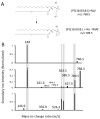Single-cell lipidomics: characterizing and imaging lipids on the surface of individual Aplysia californica neurons with cluster secondary ion mass spectrometry
- PMID: 23323749
- PMCID: PMC3867296
- DOI: 10.1021/ac303038j
Single-cell lipidomics: characterizing and imaging lipids on the surface of individual Aplysia californica neurons with cluster secondary ion mass spectrometry
Abstract
Neurons isolated from Aplysia californica , an organism with a well-defined neural network, were imaged with secondary ion mass spectrometry, C(60)-SIMS. A major lipid component of the neuronal membrane was identified as 1-hexadecyl-2-octadecenoyl-sn-glycero-3-phosphocholine [PC(16:0e/18:1)] using tandem mass spectrometry (MS/MS). The assignment was made directly off the sample surface using a C(60)-QSTAR instrument, a prototype instrument that combines an ion source with a commercial electrospray ionization/matrix-assisted laser desorption ionization (ESI/MALDI) mass spectrometer. Normal phase liquid chromatography mass spectrometry (NP-LC-MS) was used to confirm the assignment. Cholesterol and vitamin E were also identified with in situ tandem MS analyses that were compared to reference spectra obtained from purified compounds. In order to improve sensitivity on the single-cell level, the tandem MS spectrum of vitamin E reference material was used to extract and compile all the vitamin E related peaks from the cell image. The mass spectrometry images reveal heterogeneous distributions of intact lipid species, PC(16:0e/18:1), vitamin E, and cholesterol on the surface of a single neuron. The ability to detect these molecules and determine their relative distribution on the single-cell level shows that the C(60)-QSTAR is a potential platform for studying important biochemical processes, such as neuron degeneration.
Figures





Similar articles
-
Single Cell Profiling Using Ionic Liquid Matrix-Enhanced Secondary Ion Mass Spectrometry for Neuronal Cell Type Differentiation.Anal Chem. 2017 Mar 7;89(5):3078-3086. doi: 10.1021/acs.analchem.6b04819. Epub 2017 Feb 10. Anal Chem. 2017. PMID: 28194949 Free PMC article.
-
Surface analysis of lipids by mass spectrometry: more than just imaging.Prog Lipid Res. 2013 Oct;52(4):329-53. doi: 10.1016/j.plipres.2013.04.005. Epub 2013 Apr 24. Prog Lipid Res. 2013. PMID: 23623802 Review.
-
Intact lipid imaging of mouse brain samples: MALDI, nanoparticle-laser desorption ionization, and 40 keV argon cluster secondary ion mass spectrometry.Anal Bioanal Chem. 2016 Sep;408(24):6857-68. doi: 10.1007/s00216-016-9812-5. Epub 2016 Aug 22. Anal Bioanal Chem. 2016. PMID: 27549796 Free PMC article.
-
Exploiting the Semidestructive Nature of Gas Cluster Ion Beam Time-of-Flight Secondary Ion Mass Spectrometry Imaging for Simultaneous Localization and Confident Lipid Annotations.Anal Chem. 2019 Dec 3;91(23):15073-15080. doi: 10.1021/acs.analchem.9b03763. Epub 2019 Nov 11. Anal Chem. 2019. PMID: 31659904 Free PMC article.
-
Imaging with mass spectrometry, the next frontier in sphingolipid research? A discussion on where we stand and the possibilities ahead.Chem Phys Lipids. 2019 Mar;219:1-14. doi: 10.1016/j.chemphyslip.2019.01.001. Epub 2019 Jan 11. Chem Phys Lipids. 2019. PMID: 30641043 Free PMC article. Review.
Cited by
-
Small-volume analysis of cell-cell signaling molecules in the brain.Neuropsychopharmacology. 2014 Jan;39(1):50-64. doi: 10.1038/npp.2013.145. Epub 2013 Jun 10. Neuropsychopharmacology. 2014. PMID: 23748227 Free PMC article. Review.
-
Patch clamp-assisted single neuron lipidomics.Sci Rep. 2017 Jul 13;7(1):5318. doi: 10.1038/s41598-017-05607-3. Sci Rep. 2017. PMID: 28706218 Free PMC article.
-
Lipidomic Characterization of Oocytes at Single-Cell Level Using Nanoflow Chromatography-Trapped Ion Mobility Spectrometry-Mass Spectrometry.Molecules. 2023 May 19;28(10):4202. doi: 10.3390/molecules28104202. Molecules. 2023. PMID: 37241942 Free PMC article.
-
Two-dimensional and three-dimensional dynamic imaging of live biofilms in a microchannel by time-of-flight secondary ion mass spectrometry.Biomicrofluidics. 2015 May 5;9(3):031101. doi: 10.1063/1.4919807. eCollection 2015 May. Biomicrofluidics. 2015. PMID: 26015837 Free PMC article.
-
Using Dicationic Ion-Pairing Compounds To Enhance the Single Cell Mass Spectrometry Analysis Using the Single-Probe: A Microscale Sampling and Ionization Device.Anal Chem. 2016 Jul 5;88(13):6812-9. doi: 10.1021/acs.analchem.6b01284. Epub 2016 Jun 14. Anal Chem. 2016. PMID: 27239862 Free PMC article.
References
Publication types
MeSH terms
Substances
Grants and funding
LinkOut - more resources
Full Text Sources
Other Literature Sources
Miscellaneous

